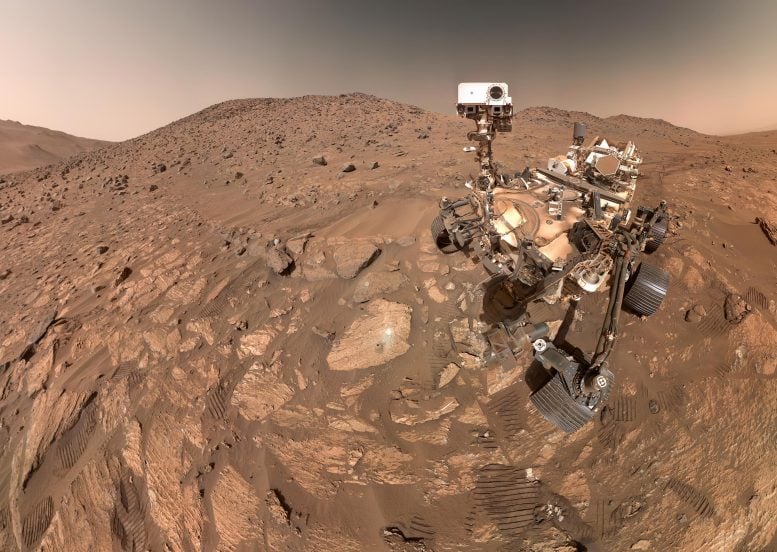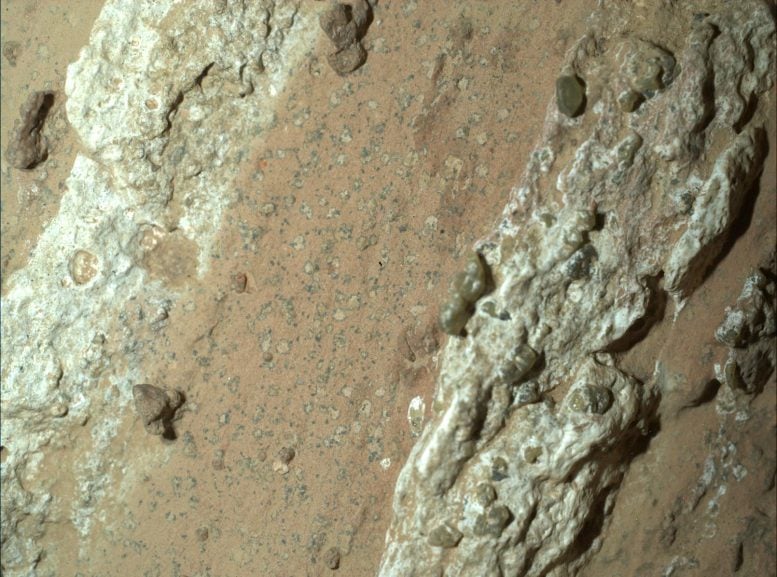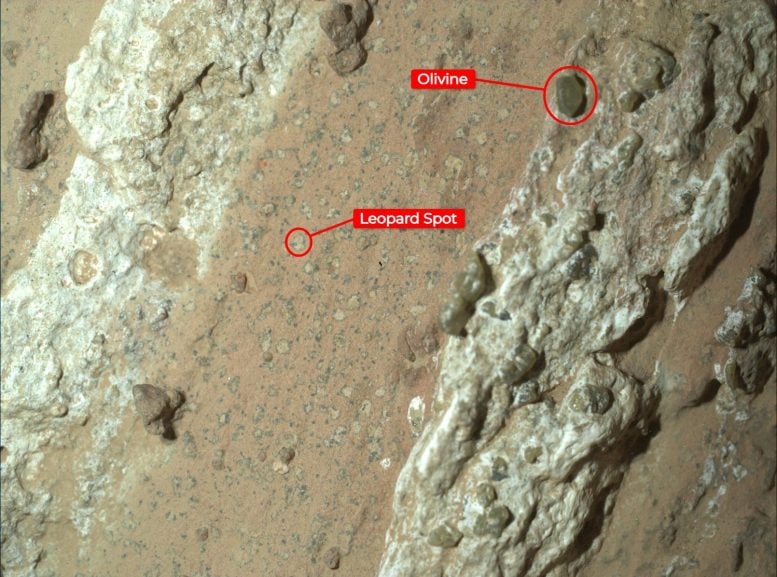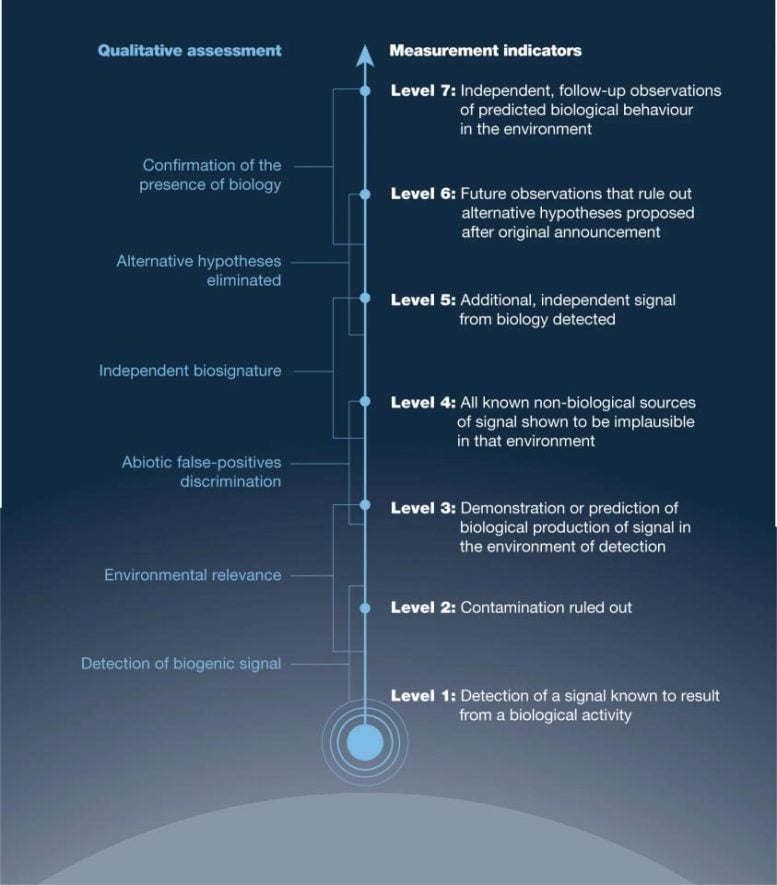
NASA’s Perseverance rover has identified its most compelling evidence yet for ancient microbial life on Mars.
A rock sample dubbed “Sapphire Canyon,” collected from the Bright Angel formation in Jezero Crater, shows mineral and chemical patterns that resemble biosignatures—possible traces of past microbial activity. These “leopard spots,” rich in iron-based minerals, could have been formed by microbial metabolisms, though non-biological processes can’t be fully ruled out.
Possible Signs of Ancient Martian Life
A rock sample gathered by NASA’s Perseverance rover in an ancient riverbed within Jezero Crater may hold evidence of past microbial life. The sample, known as “Sapphire Canyon,” was collected in 2024 from a rock called “Cheyava Falls” and is now considered one of the mission’s strongest candidates for containing potential biosignatures, according to research published today in the journal Nature.
Scientists define a potential biosignature as a material or structure that could have been formed by biological activity, but which still requires more investigation before confirming or ruling out a link to life.
This animation depicts water disappearing over time in the Martian river valley Neretva Vallis, where NASA’s Perseverance Mars takes the rock sample named “Sapphire Canyon” from a rock called “Cheyava Falls,” which was found in the “Bright Angel” formation. Credit: NASA/JPL-Caltech
“This finding by Perseverance, launched under President Trump in his first term, is the closest we have ever come to discovering life on Mars. The identification of a potential biosignature on the Red Planet is a groundbreaking discovery, and one that will advance our understanding of Mars,” said acting NASA Administrator Sean Duffy. “NASA’s commitment to conducting Gold Standard Science will continue as we pursue our goal of putting American boots on Mars’ rocky soil.”
NASA program scientist Lindsay Hays explains what defines potential signs of ancient life on other worlds and why they require future study. NASA’s Perseverance Mars rover is searching for these signs, collecting samples for future return to Earth, and helping pave the way for human exploration. Credit: NASA/JPL-Caltech
Exploring Jezero Crater’s Bright Angel Formation
In July 2024, Perseverance reached Cheyava Falls while studying the “Bright Angel” formation, a series of rocky outcrops along both sides of Neretva Vallis, a river valley about a quarter-mile (400 meters) wide that was carved long ago by water flowing into Jezero Crater.
“This finding is the direct result of NASA’s effort to strategically plan, develop, and execute a mission able to deliver exactly this type of science — the identification of a potential biosignature on Mars,” said Nicky Fox, associate administrator, Science Mission Directorate at NASA Headquarters in Washington. “With the publication of this peer-reviewed result, NASA makes this data available to the wider science community for further study to confirm or refute its biological potential.”

Sedimentary Rocks Rich in Organic Material
The rover’s science instruments found that the formation’s sedimentary rocks are composed of clay and silt, which, on Earth, are excellent preservers of past microbial life. They are also rich in organic carbon, sulfur, oxidized iron (rust), and phosphorus.
“The combination of chemical compounds we found in the Bright Angel formation could have been a rich source of energy for microbial metabolisms,” said Perseverance scientist Joel Hurowitz of Stony Brook University, New York, and lead author of the paper. “But just because we saw all these compelling chemical signatures in the data didn’t mean we had a potential biosignature. We needed to analyze what that data could mean.”

Strange Spots and Chemical Fingerprints
First to collect data on this rock were Perseverance’s PIXL (Planetary Instrument for X-ray Lithochemistry) and SHERLOC (Scanning Habitable Environments with Raman & Luminescence for Organics & Chemicals) instruments. While investigating Cheyava Falls, an arrowhead-shaped rock measuring 3.2 feet by 2 feet (1 meter by 0.6 meters), they found what appeared to be colorful spots. The spots on the rock could have been left behind by microbial life if it had used the raw ingredients, the organic carbon, sulfur, and phosphorus, in the rock as an energy source.
Leopard Spots: Clues in Mineral Patterns
In higher-resolution images, the instruments found a distinct pattern of minerals arranged into reaction fronts (points of contact where chemical and physical reactions occur) the team called leopard spots. The spots carried the signature of two iron-rich minerals: vivianite (hydrated iron phosphate) and greigite (iron sulfide). Vivianite is frequently found on Earth in sediments, peat bogs, and around decaying organic matter. Similarly, certain forms of microbial life on Earth can produce greigite.
The combination of these minerals, which appear to have formed by electron-transfer reactions between the sediment and organic matter, is a potential fingerprint for microbial life, which would use these reactions to produce energy for growth. The minerals also can be generated abiotically, or without the presence of life. Hence, there are ways to produce them without biological reactions, including sustained high temperatures, acidic conditions, and binding by organic compounds. However, the rocks at Bright Angel do not show evidence that they experienced high temperatures or acidic conditions, and it is unknown whether the organic compounds present would’ve been capable of catalyzing the reaction at low temperatures.
Implications for Mars’ Habitability Timeline
The discovery was particularly surprising because it involves some of the youngest sedimentary rocks the mission has investigated. An earlier hypothesis assumed signs of ancient life would be confined to older rock formations. This finding suggests that Mars could have been habitable for a longer period or later in the planet’s history than previously thought, and that older rocks also might hold signs of life that are simply harder to detect.

Extraordinary Evidence Needed
“Astrobiological claims, particularly those related to the potential discovery of past extraterrestrial life, require extraordinary evidence,” said Katie Stack Morgan, Perseverance’s project scientist at NASA’s Jet Propulsion Laboratory in Southern California. “Getting such a significant finding as a potential biosignature on Mars into a peer-reviewed publication is a crucial step in the scientific process because it ensures the rigor, validity, and significance of our results. And while abiotic explanations for what we see at Bright Angel are less likely given the paper’s findings, we cannot rule them out.”
The scientific community uses tools and frameworks like the CoLD scale and Standards of Evidence to assess whether data related to the search for life actually answers the question, Are we alone? Such tools help improve understanding of how much confidence to place in data suggesting a possible signal of life found outside our own planet.
Perseverance’s Growing Rock Collection
Sapphire Canyon is one of 27 rock cores the rover has collected since landing at Jezero Crater in February 2021. Among the suite of science instruments is a weather station that provides environmental information for future human missions, as well as swatches of spacesuit material so that NASA can study how it fares on Mars.
Reference: “Redox-driven mineral and organic associations in Jezero Crater, Mars” by Joel A. Hurowitz, M. M. Tice, A. C. Allwood, M. L. Cable, K. P. Hand, A. E. Murphy, K. Uckert, J. F. Bell III, T. Bosak, A. P. Broz, E. Clavé, A. Cousin, S. Davidoff, E. Dehouck, K. A. Farley, S. Gupta, S.-E. Hamran, K. Hickman-Lewis, J. R. Johnson, A. J. Jones, M. W. M. Jones, P. S. Jørgensen, L. C. Kah, H. Kalucha, T. V. Kizovski, D. A. Klevang, Y. Liu, F. M. McCubbin, E. L. Moreland, G. Paar, D. A. Paige, A. C. Pascuzzo, M. S. Rice, M. E. Schmidt, K. L. Siebach, S. Siljeström, J. I. Simon, K. M. Stack, A. Steele, N. J. Tosca, A. H. Treiman, S. J. VanBommel, L. A. Wade, B. P. Weiss, R. C. Wiens, K. H. Williford, R. Barnes, P. A. Barr, A. Bechtold, P. Beck, K. Benzerara, S. Bernard, O. Beyssac, R. Bhartia, A. J. Brown, G. Caravaca, E. L. Cardarelli, E. A. Cloutis, A. G. Fairén, D. T. Flannery, T. Fornaro, T. Fouchet, B. Garczynski, F. Goméz, E. M. Hausrath, C. M. Heirwegh, C. D. K. Herd, J. E. Huggett, J. L. Jørgensen, S. W. Lee, A. Y. Li, J. N. Maki, L. Mandon, N. Mangold, J. A. Manrique, J. Martínez-Frías, J. I. Núñez, L. P. O’Neil, B. J. Orenstein, N. Phelan, C. Quantin-Nataf, P. Russell, M. D. Schulte, E. Scheller, S. Sharma, D. L. Shuster, A. Srivastava, B. V. Wogsland and Z. U. Wolf, 10 September 2025, Nature.
DOI: 10.1038/s41586-025-09413-0
Perseverance is NASA’s most advanced Mars rover, designed to search for signs of past microbial life and collect rock samples for possible return to Earth. Built and operated by NASA’s Jet Propulsion Laboratory (JPL) in Pasadena, California, the rover is managed for NASA by Caltech on behalf of the agency’s Science Mission Directorate. It is a key mission within NASA’s broader Mars Exploration Program, which is focused on understanding the Red Planet’s geology, climate, and potential for life. Perseverance also carries technology demonstrations to prepare for future human exploration.
Never miss a breakthrough: Join the SciTechDaily newsletter.
2 Comments
Way too much excitement for way too little evidence…IMHO.
Yes, finally much more evidence than genesis in the bible!